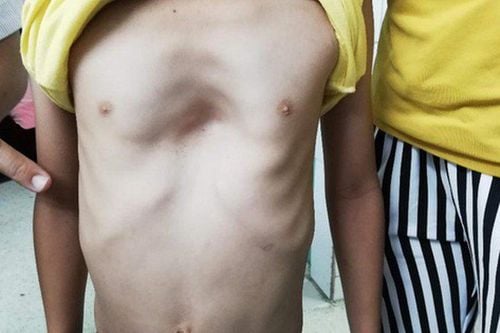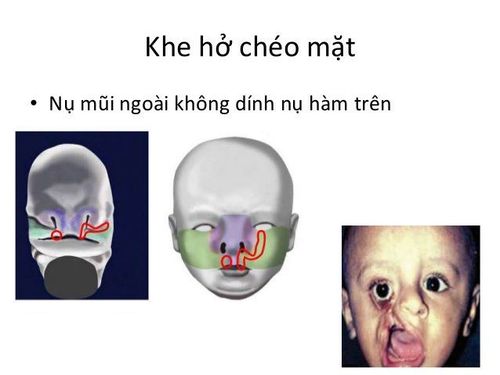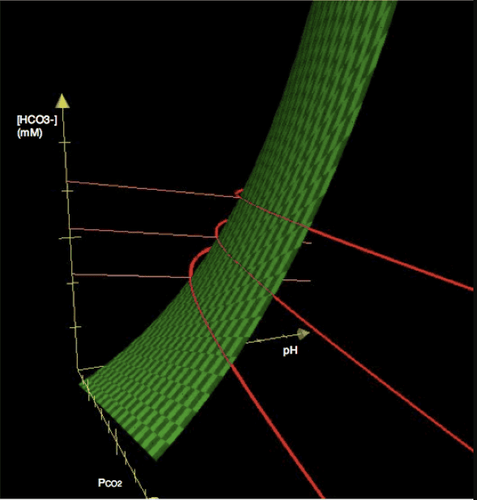This is an automatically translated article.
The article was professionally consulted by Specialist Doctor I Nguyen Thi My Linh - Neonatologist - Department of Pediatrics - Neonatology - Vinmec Danang International General Hospital. Specialist Doctor I Nguyen Thi My Linh has 12 years of experience in diagnosing and treating pediatric diseases.1. What is posterior nasal obstruction in infants?
The nose is an organ that is formed from the 4th week of pregnancy. During the development process, due to a number of unusual causes (influenza virus infection, Rubella infection, the influence of drugs used by the mother, etc.), children may experience unusual changes, including allergies nasal form such as posterior nasal stenosis.Posterior stenosis is a congenital malformation of the nose, characterized by a thin membrane or a bony mass that blocks the posterior nasal opening. Posterior nasal obstruction due to abnormalities in the nasal area, nasal septum, or bone between the nose and throat. The child may have a narrowing in one or both sides of the nose.

2. Is posterior narrowing of the nose dangerous?
Obstruction of posterior nasal stenosis is the cause of obstructing the respiratory activities of children, causing stagnation of nasal secretions, leading to bad progress with different degrees.In mild form, the child will have intermittent cyanosis, accompanied by difficulty eating, there is a high risk of aspiration because they have to breathe through the mouth. In severe form, the posterior nasal obstruction causes upper respiratory obstruction, causing cyanosis and respiratory failure right after birth. On the other hand, the child can develop pneumonia.
In particular, children with posterior nasal narrowing are at risk of death from choking on milk (because babies have to breathe through their mouths while feeding, so they easily choke), they can even stop breathing, causing death during sleep due to tongue drop. posteriorly leading to airway obstruction.

3. Diagnosis of posterior nasal stenosis in neonates
Through symptoms: The child has cyanosis and difficulty breathing right from birth. After that, children often have a runny nose, have to breathe through their mouth, overwhelmed when sucking, choking; Check: Using a nasal probe to probe cannot go down the throat or mouth, checking the airways does not detect breathing through the nose, drops of dye from the nose cannot go down the throat but spill out; Paraclinical examination: Performing lateral cranial X-ray with intranasal contrast injection will detect posterior nasal obstruction or narrowing. In these cases, the doctor usually appoints a flexible nasal endoscopy or CT scan to confirm the diagnosis and evaluate the posterior nasal narrowing. Symptoms: If the child completely blocked the posterior nostril, the child will have characteristic symptoms: pink lips when crying and purple when the child is still.4. Treatment of posterior nasal stenosis
In cases of narrowing of the posterior nasal passage on one side, which causes little difficulty in breathing, it can be delayed and handled later.In case the posterior nasal narrowing obstructs the child's breathing, it should be treated early by surgery to help the child breathe easily. Usually, from the age of 2 months, surgery can be performed.

For children with posterior nasal obstruction causing respiratory failure, it is necessary to intubate and then perform posterior rhinoplasty. If the child has accompanying cardiovascular abnormalities, the tracheostomy must be performed, only performing rhinoplasty after conditions allow.
Note: After surgery, it is necessary to place a nasal stent for 10-15 days to avoid narrowing.
Posterior nasal stenosis in newborns is a dangerous condition, which should be detected for early treatment, to avoid the risk of respiratory failure, pneumonia or aspiration of milk into the lungs, which can be life-threatening.
Please dial HOTLINE for more information or register for an appointment HERE. Download MyVinmec app to make appointments faster and to manage your bookings easily.














